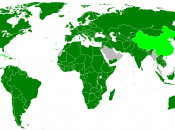Australia as a state is a signatory party to over 900 treaties, which through the terms of their provisions and ratification entail an obligation to act in compliance with that obligation.
Although it is a well-settled principle that the ratification of a treaty does not form part of Australian domestic law unless passed into legislation by parliament , a treaty unincorporated into legislation may still bear an influence on the development of common law and the making of administrative decisions .
There has been an ever-increasing gap, between the reality of what the state should be doing in compliance with its obligations, and the actions it has actually taken. "Despite a commitment to internationalism in Australia's human rights diplomacy, international statements of human rights have been enacted as part of domestic law in only a very small number of cases" , given this lack of active legislating to ensure compliance, it is not surprising the Australian courts have had to determine the role of human rights and their application to Australian law.
The current role of human rights in Australian common law is in a state of flux, a position espoused by Kirby J in Newcrest Mining (WA) Ltd v Commonwealth . This suggestion both provides an accurate general depiction of the application of international human rights to Australian common law, and holds much truth given the limited historical existence and operation of international human rights.
Much of the common laws recognition of human rights in Australia has been inherited from English common law, with the most notable developments being the Magna Carta 1215, and the Bill of Rights 1688, which bore resemblance to the modern human rights provisions .
The traditional position of the courts in relation to the use of international human rights has been a reluctance to...


